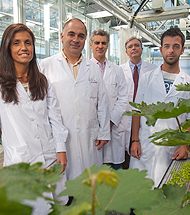Three University projects receive funding from the regional government for equipment and infrastructures for the research and development
Two of them are among the four projects that have obtained a higher score in the call for proposals.


Three projects of the University of Navarra have obtained funding in a call of the Regional Government for the provision of equipment and infrastructures of research and development to technology centers and organizations of research, and their adaptation to the new post-COVID-19 normality.
The criteria taken into account when awarding these grants, which will cover 50% of each project, are focused on recognizing the excellence and rigor of the scientific-technical proposal , staff available ; impact in terms of scientific results, employment and development sustainable; shared use with other agents of the SINAI (Navarra System of research and development+i), and adaptation to the new normality derived from COVID-19.
As a novelty, this year the aim is to facilitate the adaptation of research infrastructures to the new normality. To this end, it has been assessed that all research facilities have appropriate means of protection, complying with the recommendations issued by the health and labor authorities.
In total, the Government of Navarra will allocate 2 million euros to 28 projects from 10 centers. Two of the projects presented by the University are among the four projects that have obtained a higher score in the call.
The "Orbitrap-Exploris 120" is a high resolution mass spectrometer incorporating Orbitrap technology. This technology is the only one on the market with the ability to analyze very small molecular weights (metabolites such as sugars, amino acids, plant hormones, organic acids, etc.), combined with very high sensitivity. It also allows the research of unknown compounds thanks to its high mass accuracy and structural elucidation capability.
The equipment will be used by the group of research BACH (Biological and Agricultural Chemistry) of the department of Environmental Biology of the School of Sciences of the University of Navarra. It will be used in research projects to be carried out at partnership with the Public University of Navarra, the Lurederra Technology Center and the CSIC. For example, the role of plant hormones in legumes grown under drought conditions, the reduction of nitrate content in vegetables, the development of new generation biofertilizers, etc. will be studied.
It has an budget of 202,268 euros, of which the Government of Navarra will finance 101,134 euros.
The "MicroSPECT-CT" allows high-resolution metabolic and anatomical images to be obtained in animal models of human diseases using radiolabeled compounds. It is the first equipment of its kind class in Navarra. It will enable collaborative projects in translational molecular imaging for in vivo and non-invasive monitoring in animal models of a large number of metabolic processes, as well as for the development of new drugs and research in personalized medicine, advanced therapies and radionano-pharmacobiology.
The equipment will be managed by the group of research in Radiopharmacology, Radiopharmacobiology and Translational Molecular Imaging (RADIOMIN) of the University of Navarra. It will be installed in the Preclinical Molecular Imaging Unit of the University of Navarra, a Support Unit for research of IdiSNA, so it will be available to all researchers at high school.
The cost of this initiative is 456,200 euros, of which 228,100 euros will be subsidized.
The third of the projects that has obtained funding in this call has been the high school of research in Biodiversity and Environment (BIOMA) for the acquisition of a modular analytical equipment, unique in Spain, with a wide range of applications in different areas of research.
The equipment will be installed at laboratory Integrated Environmental Quality (LICA) and consists of a Centri multimode platform coupled to a gas chromatograph and a high-resolution time-of-flight mass spectrometer (Centri-GC-Bench TOF-MS) for the determination of organic compounds in a wide range of sample types (solid, liquid and gaseous).
The versatility of the new equipment will contribute to the creation of interdisciplinary groups of work, the partnership university-business and the realization of projects of research of research and development+I at different scales, favoring the transfer of results and the internationalization.
